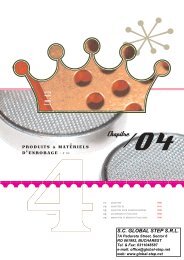Electrophoresis
Electrophoresis
Electrophoresis
You also want an ePaper? Increase the reach of your titles
YUMPU automatically turns print PDFs into web optimized ePapers that Google loves.
Elektrophorese<br />
<strong>Electrophoresis</strong> · Agarose and Gelling<br />
2180 -<br />
1030 -<br />
Agarose Super LM<br />
Roti ® garose for gel elution from melted agarose,<br />
capillary electrophoresis and in-gel-processing<br />
Low melting agarose with particularly low gelling and melting temperatures.<br />
For DNA recovery of fragments over 1000 bp and for special applications.<br />
• Fine resolution of fragments over 1000 bp<br />
• Very well suited for analysis and recovery of longer PCR amplificates<br />
or other longer fragments like vectors, rare cutter digestions etc.<br />
• Recommended for in-gel-applications, virus plaque-assays<br />
and tissue/cell culture applications<br />
• Low gel background, compatible with all standard nucleic acid-staining<br />
methods<br />
• Lower gel strength than Agarose Low Melt. Recommended for use in<br />
concentrations of over 1 % agarose<br />
Guarantee analysis:<br />
Electroendosmosis (EEO). ..................................................................................≤0,12<br />
Water content. ......................................................................................................≤7 %<br />
Ash. .................................................................................................................≤0,35 %<br />
Sulphate (SO4). ...............................................................................................≤0,14 %<br />
Gel strength (1.5 % gel). .............................................................................≥300 g/cm2 Gelling temperature (1.5 % gel).....................................................................≤20 °C<br />
Melting temperature (1.5 % gel). ...................................................................≤62 °C<br />
Turbidity (1.5 % solution). ................................................................................ ≤4 NTU<br />
DNases, RNases. .................................................................................. none detected<br />
HP45.1 5 g plastic 33,20 €<br />
HP45.2 100 g plastic 464,40 €<br />
HP45.3 250 g plastic 985,80 €<br />
Agarose HEEO ultra-quality<br />
Roti ® garose for electrophoresis<br />
High electroendosmosis (EEO = 0.23-0.26)<br />
• Special agarose for protein separation and countercurrent<br />
electrophoresis<br />
• Gels are well-to-handle and have a strong matrix,<br />
even when using thin gels of 1-2 mm<br />
• Very clear and transparent matrix, even for thick gels<br />
Guarantee analysis:<br />
Electroendosmosis (EEO). ............................................................................0,23-0,26<br />
Water content. ......................................................................................................≤7 %<br />
Ash. ...................................................................................................................≤1,0 %<br />
Sulphate (SO 4). .................................................................................................≤0,2 %<br />
Gel strength (1 % gel). ................................................................................≥750 g/cm 2<br />
Gel strength (1.5 % gel). ...........................................................................≥1200 g/cm 2<br />
Gelling temperature (1.5 % gel). ..................................................................36 ±1,5 °C<br />
Melting temperature (1.5 % gel)...................................................................88 ±1,5 °C<br />
Turbidity (1.5 % solution). ................................................................................ ≤4 NTU<br />
2269.1 10 g plastic 17,65 €<br />
2269.2 100 g plastic 97,35 €<br />
2269.3 1 kg plastic 708,45 €<br />
Original pack 6 x 1 kg 673,03/1 kg<br />
858<br />
1,8 % Agarose in 1 x TAE<br />
bp<br />
bp<br />
590 -<br />
430 -<br />
270 -<br />
184 -<br />
124 -<br />
- 1500<br />
- 1000<br />
- 500<br />
- 300<br />
- 100<br />
BIG<br />
BIG<br />
PACK PACK PACK<br />
DNAse-free<br />
RNAse-free<br />
bp<br />
3700 -<br />
1300 -<br />
622 -<br />
527 -<br />
404 -<br />
309 -<br />
240 -<br />
160 -<br />
123 -<br />
1.5 % Synergel TM<br />
+ 0.7 % agarose<br />
Synergel<br />
≥99 %<br />
For gel electrophoresis.<br />
Agarose additive<br />
Store at +20 °C<br />
TM<br />
• Enhances separation of nucleic acid fragments<br />
• For extremely clear gels<br />
Synergel TM is a synergistic gelling and sieving agent consisting of a<br />
modified polysaccharide which, when combined with agarose, forms a<br />
hydrogen bonded binary gel system. The addition of Synergel TM to agarose<br />
improves gel performance by providing superior separation and definition<br />
of DNA fragments up to 30 kb. A gel mixture containing 0.7 % agarose and<br />
1.0 % Synergel TM , e.g., will produce improved results when compared to a<br />
2 % agarose-only gel. Synergel TM also provides greater optical clarity,<br />
which allows higher quality photodocumentation of stained gels.<br />
Figure 1 compares separation qualities of A: 1.5 % SynergelTM / 0.7 %<br />
agarose and B: 4 % high-resolution agarose (NuSieve ® ). Please see also<br />
figures for pUC19 markers T149 and X901. Standard buffer systems like<br />
phosphate, acetate or borate buffered Tris-EDTA may be used in forming<br />
the gel. RNA may also be separated in this system by using a 2.2 M formaldehyde-containing<br />
buffer. Nucleic acid may be electroeluted or transferred<br />
to membranes following standard Southern/Northern blotting protocols.<br />
Type analysis:<br />
Colour............................................................................................................. off-white<br />
Odour. .......................................................................................................slightly salty<br />
pH (1 % solution). .......................................................................................................9<br />
DNase, RNase....................................................................................... none detected<br />
0184.2 10 g plastic 24,35 €<br />
0184.1 100 g plastic 170,95 €<br />
How to Calculate Required Synergel TM<br />
Global Step - Email : Office@global-step.net<br />
Telefon : (+4) 0742 095 539<br />
Tel/Fax : (+4) 031 104 85 87<br />
Mobil : (+4) 0720 095 539, 0723 442 593<br />
4 % agarose<br />
A B<br />
1. What percentage agarose gel is currently being used?<br />
2. The gel will inevitably contain 0.7 % agarose<br />
(the minimum agarose concentration required to ensure gel stability).<br />
Hence, subtract 0.7 % from the agarose total.<br />
3. Divide the difference by 2. The result is the percentage of Synergel TM to be<br />
added to the 0.7 % agarose.<br />
DNAse-free<br />
RNAse-free<br />
Example:<br />
Convert a 1 % agarose to a 1 % SynergelTM /agarose gel<br />
a. Substract 0.7 % from the 1 % agarose: 1 % - 0.7 % = 0.3 %<br />
b. Divide the difference by 2: 0.3 % : 2 = 0.15 %<br />
c. 0.15 % (150 mg / 100 ml) is the amount of SynergelTM added to 0.7 % agarose<br />
(0.7 g / 100 ml) to produce the functional equivalent of a 1 % agarose gel.




